|
This past decade has brought volunteers of all backgrounds into our FWC family. We are so proud of your work that we focused our agency’s 2019-2020 Volunteer Annual Report on your contribution to conservation over the past ten years. Our report recognizes the success of the FWC’s investment in volunteer management and celebrates the dedicated volunteers who share their time and talents with us. View our Annual Report on the FWC’s website and enjoy a look back as we celebrate a Decade of Volunteer Conservation Action.
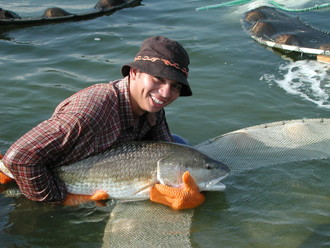 Featured on the cover of the annual report, Volunteer Aliben Paz collects an adult red drum from hatchery brood stock ponds to be used for marine stock enhancement research. Photo by the FWC.
During the transition from fall to winter, we continued to manage our volunteer projects to ensure your safety. Know that we value recognizing your effort, improving the quality and professionalism of our volunteer management and creating meaningful opportunities for you to engage with the agency in fish and wildlife conservation. We are so grateful for your continued support!
Enjoy this edition of our fall-winter newsletter which shares encouraging volunteer to career and career to volunteer stories as well as habitat restoration projects and wildlife research.
— the FWC's Volunteer Program Team
Project Acorn
By Tessie Offner
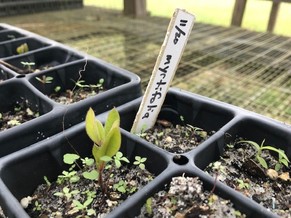 A myrtle oak sprout planted in November 2020. Photo by the FWC.
This past fall acorns from three species of scrub oak were gathered by Ridge Rangers for propagation at the native plant nursery at the Royce unit of the Lake Wales Ridge Wildlife and Environmental Area. During the fall and winter months Ridge Ranger volunteers who are part of the Lake Placid Garden Club planted acorns and weeded pots from the previous year’s saplings. The myrtle oak, sandhill oak and Chapman oak provide forage and habitat for native wildlife in the scrub ecosystem along the Lake Wales Ridge. In the spring and summer months Ridge Rangers participate in restoration planting activities using these oaks and other Florida native plants as part of Project Acorn. The goal is to improve habitat for the benefit of the Florida scrub-jay. Acorns gathered in the early fall are already beginning to germinate. We thank all the Ridge Rangers volunteers for their dedication to habitat restoration and look forward to planting these trees during a future restoration event.
 Scrub oak and native scrub wild olive saplings ready to be planted during a future restoration event. The acorns and olive fruits were collected by Ridge Rangers and FWC staff and cultivated by Ridge Rangers as part of Project Acorn. Photo by the FWC.
Debris Cleanup
By Andrea Pereyra
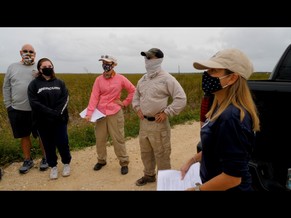 FWC staff explained to volunteers the threats debris and litter pose on fish and wildlife. Photo by the FWC.
Late fall is a perfect time to enjoy the weather in hot South Florida. In November, the FWC and Fishing with America’s Finest joined forces to clean up a popular spot amongst fishermen and wildlife viewers. The area serviced corresponded to the south border of the Everglades and Francis S. Taylor Wildlife Management Area by Tamiami Trail.
A very diverse pool of volunteers such as families with kids, retirees, Veterans and young professionals came to the rescue of our Florida public lands. Armed with trash grabbers, gloves and even a fishing rod, the group walked a three- mile stretch searching for trash. Most of the items collected were food wrappers, plastic bags, aluminum cans and glass bottles. We also removed fishing line and a bike. We could not have accomplished this without the collaboration of Capt. Neal Stark, President and Founder of Fishing with America’s Finest. Thank you, Capt. Neal and volunteers!
Debris and litter pose a high risk to fish and wildlife through entanglement and ingestion. Please remember to properly dispose your trash after enjoying the outdoors.
Visit https://myfwc.com/boating/stash-the-trash/ for more information on waterway cleanup events and instructions to make your own trash collecting container!
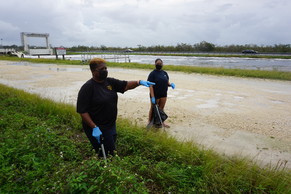
Mother and daughter volunteers gave back to Florida’s public lands. Photo by the FWC.
 Volunteer reeled in a plastic bag floating in the marsh. Photo by the FWC.
 Thank you volunteers! Photo by the FWC.
Skunk Observation Project
By Brendan O'Connor
FWC biologists are interested in gathering observations of eastern spotted skunks and striped skunks for the Skunk Observation Project.
FWC biologists are concerned about the eastern spotted skunk because of its decline in other states across its range. The FWC’s Skunk Observation Project is looking to fill potential gaps in location data around the state, especially in areas where skunks are considered rare.
You can report your observations by accessing the survey through your browser at www.myfwc.com/skunksurvey or, alternatively, through the Survey123 app. Both methods allow you to upload any photographs of skunks, as well as confirm the location, time and date of your sighting.
For more information on skunks and this project visit MyFWC.com/skunks.
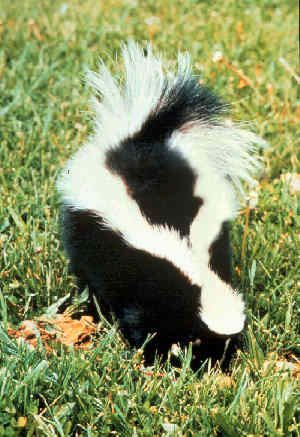 Striped skunks are usually black with two white stripes running down their back, have a narrow white stripe down the center of their face and have a long fluffy black tail. Photo by the FWC.

Eastern spotted skunks are mainly black with a series of broken-up white stripes, have white downward pointed triangle on the forehead and have a bushy tail that is white underneath and at the tip. Photo by the FWC.
|